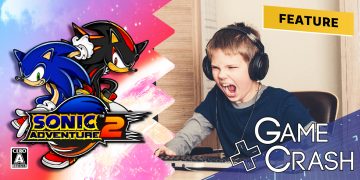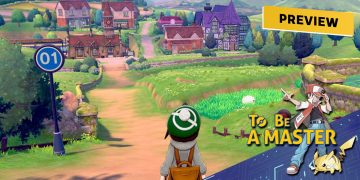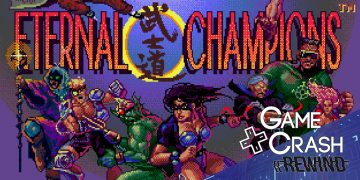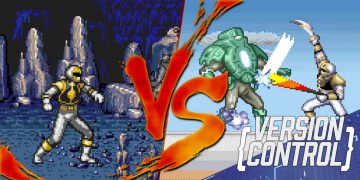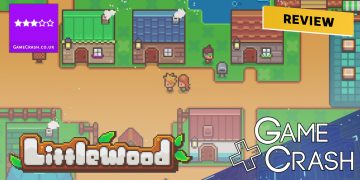Of all the games we’ll ever cover in this feature series, none will have captured the attention of the Internet quite as much as this one has.
Aladdin isn’t just considered one of Disney’s best animated movies, but also one of its best video games. Or should that be two of its best?
Although an Aladdin game was released on both the SEGA Mega Drive and the Super Nintendo at around the same time, they were developed entirely separately.
For SEGA, Virgin Games’ David Perry led the development on his last game for the company following a prolific career there. The SNES game, meanwhile, was developed by Capcom under Shinji Mikami. Coincidentally, both men would subsequently – as their very next projects – go on to create the two series they’re both most well known for respectively: Earthworm Jim and Resident Evil.
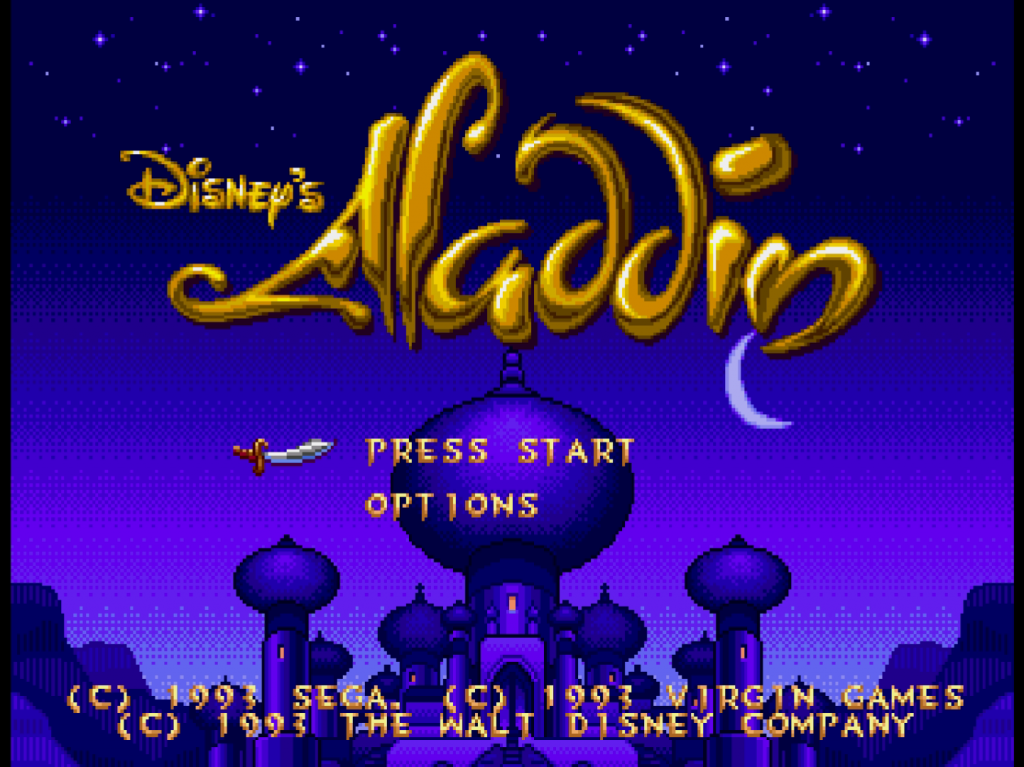
Mega Drive 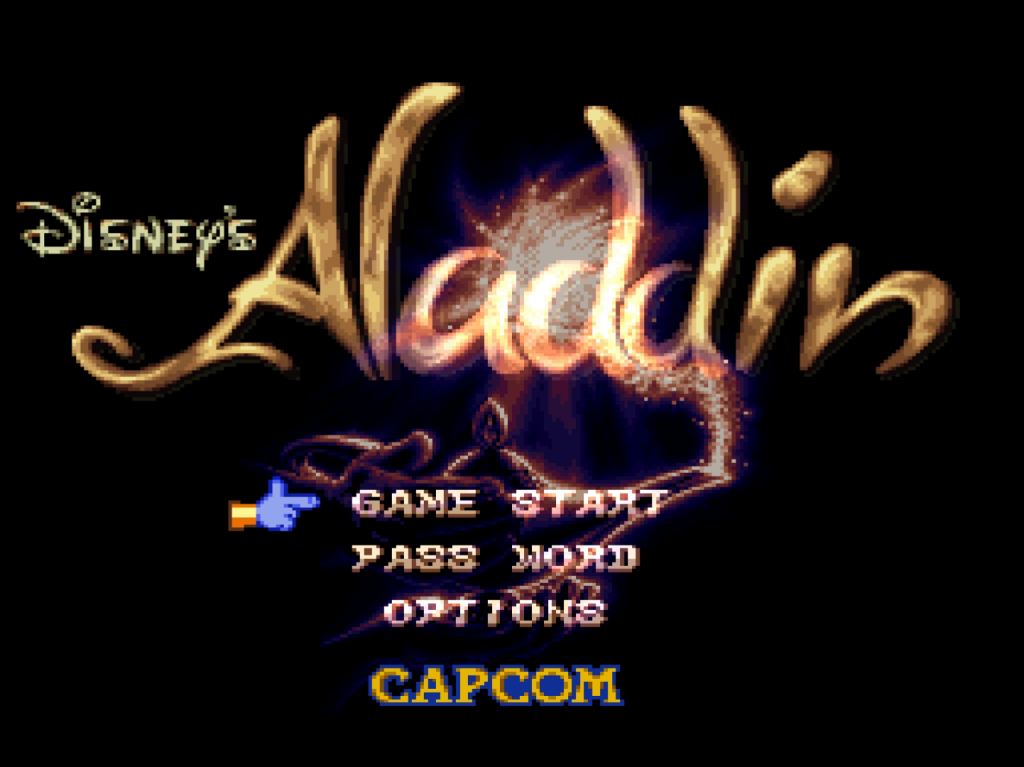
SNES
What is this game?
No matter which version you are playing, the game is a relatively faithful adaptation of the animated Disney movie. The film’s plot is told through basic cut-scenes in each game, in-between levels based off of key moments from the movie.
As both games are adaptations, they obviously share quite a lot in common. They mostly share the same set pieces as levels. There’s a bonus item slot machine accessible between levels in both games. The two even feature entirely original desert-themed levels as their only non-movie settings.
It’s the differences, though, that keeps the Internet flame war alive. So what are they? Which version of Aladdin really is the best? Let’s finally settle it once and for all.
The Mega Drive version
This version of the game plays things a little bit looser when it comes to sticking to the plot of the movie. Here, Aladdin is not captured on the streets of Agrabah while saving Jasmine. Instead, a disguised Jafar tasks him with finding the two halves of the magical scarab we see him with at the start of the movie. Upon collecting both halves, then Aladdin is captured and sent to the Sultan’s dungeon.
Effectively, this is done to find an excuse to add the game’s desert level and extend its overall length. Something also achieved by returning to Agrabah for level 3 – although this one plays quite differently to the first.
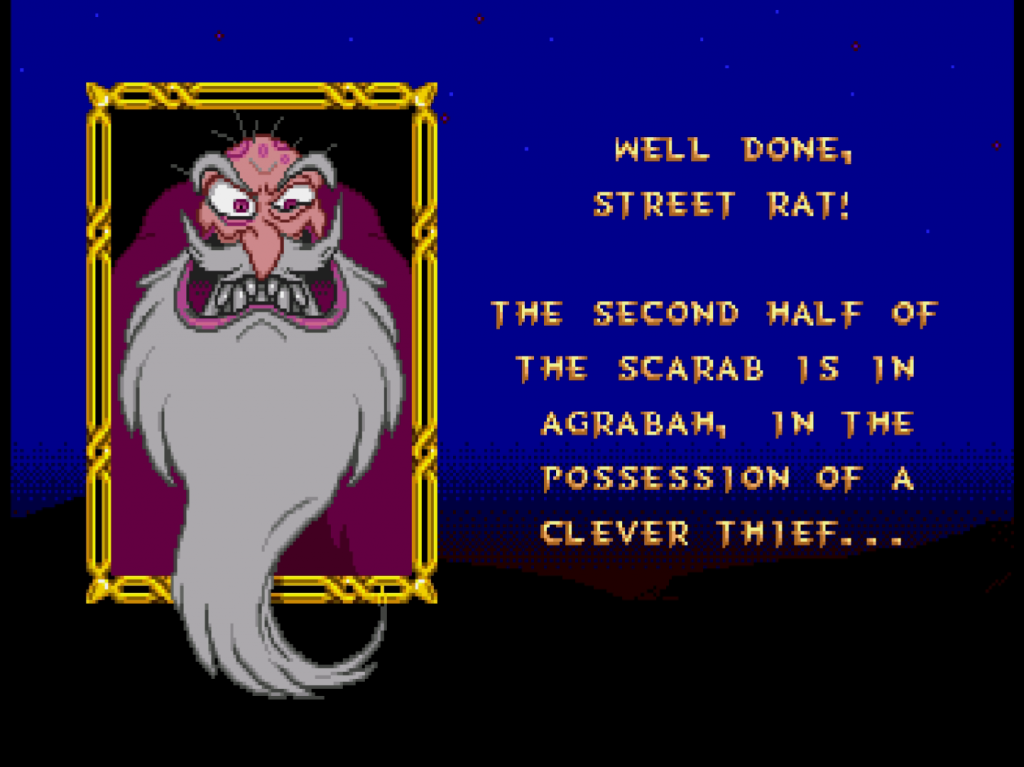
The MD version’s story presentation 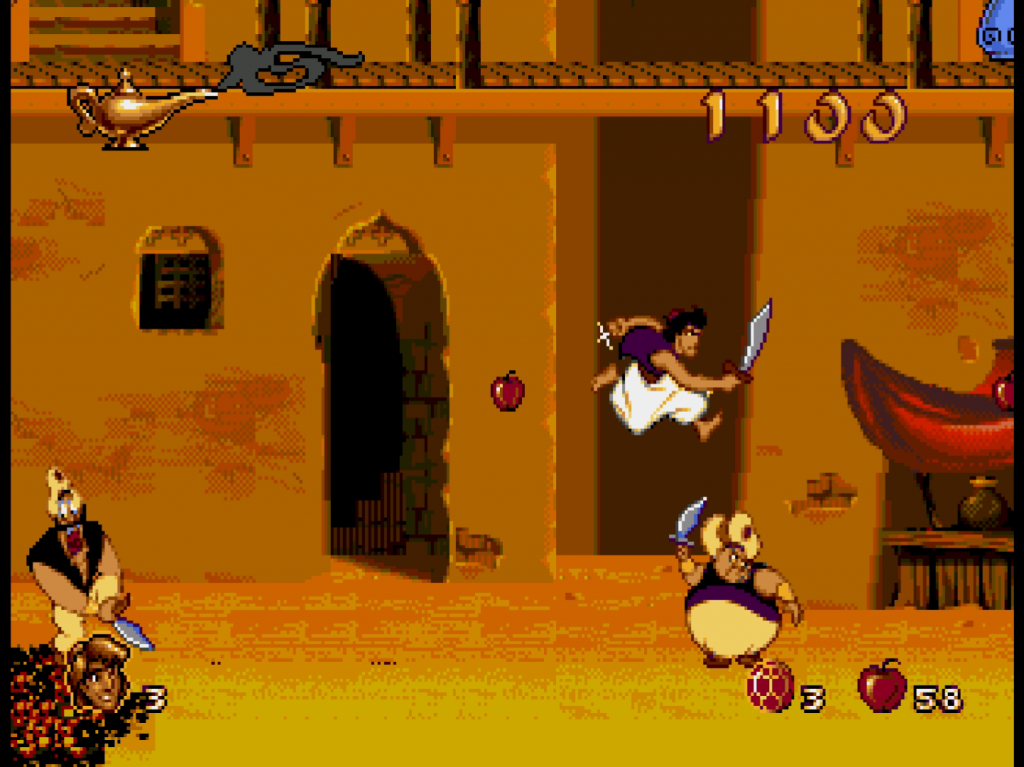
Level 1: Agrabah Streets 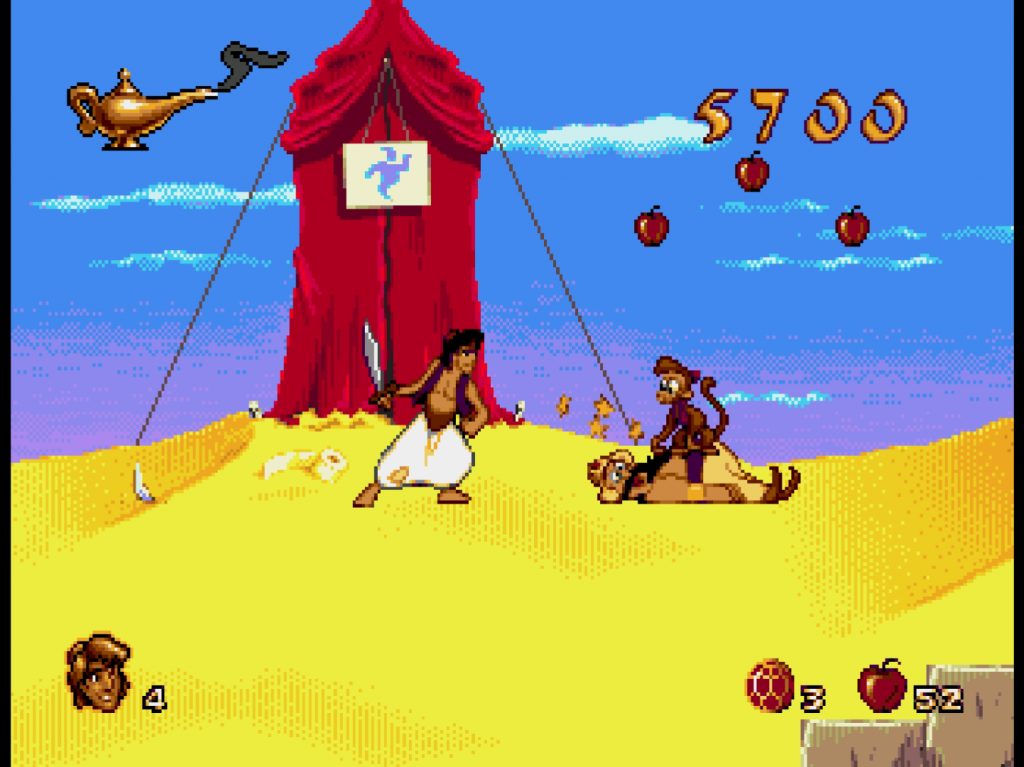
Level 2: The Desert 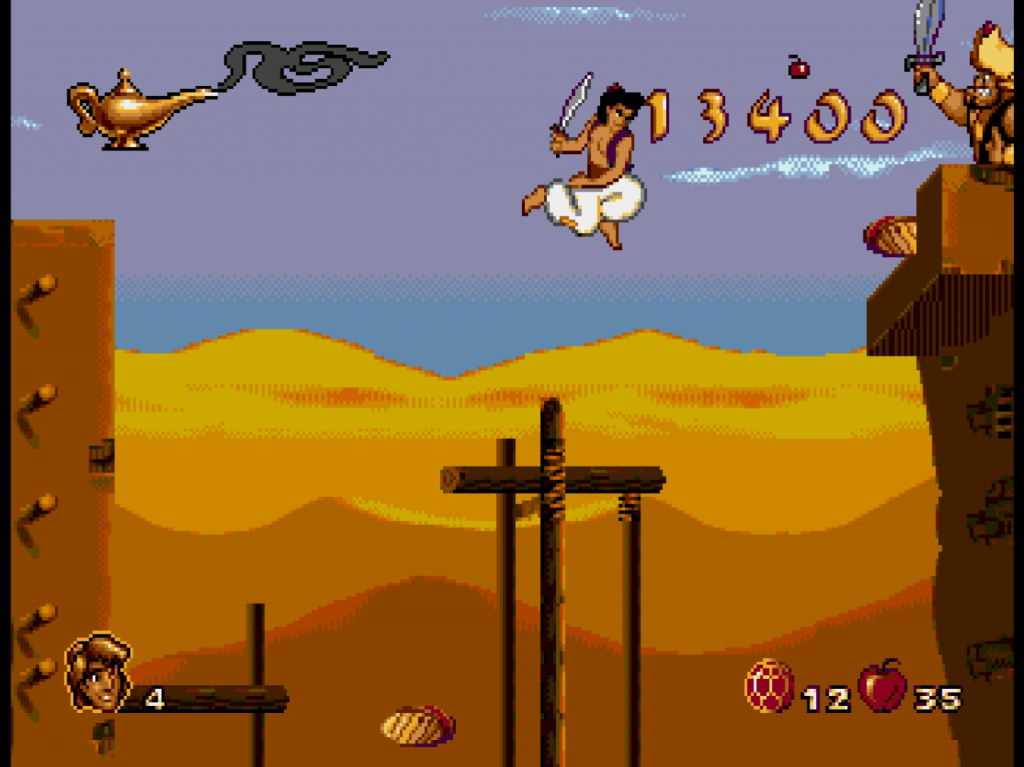
Level 3: Agrabah Rooftops 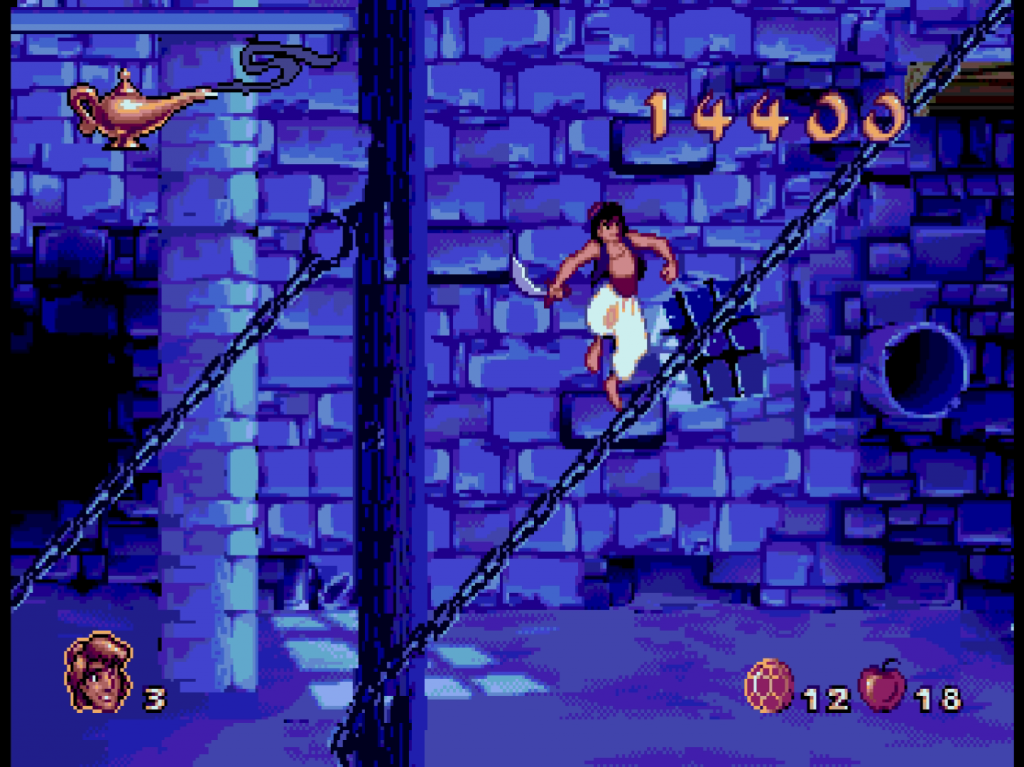
Level 4: Sultan’s Dungeon 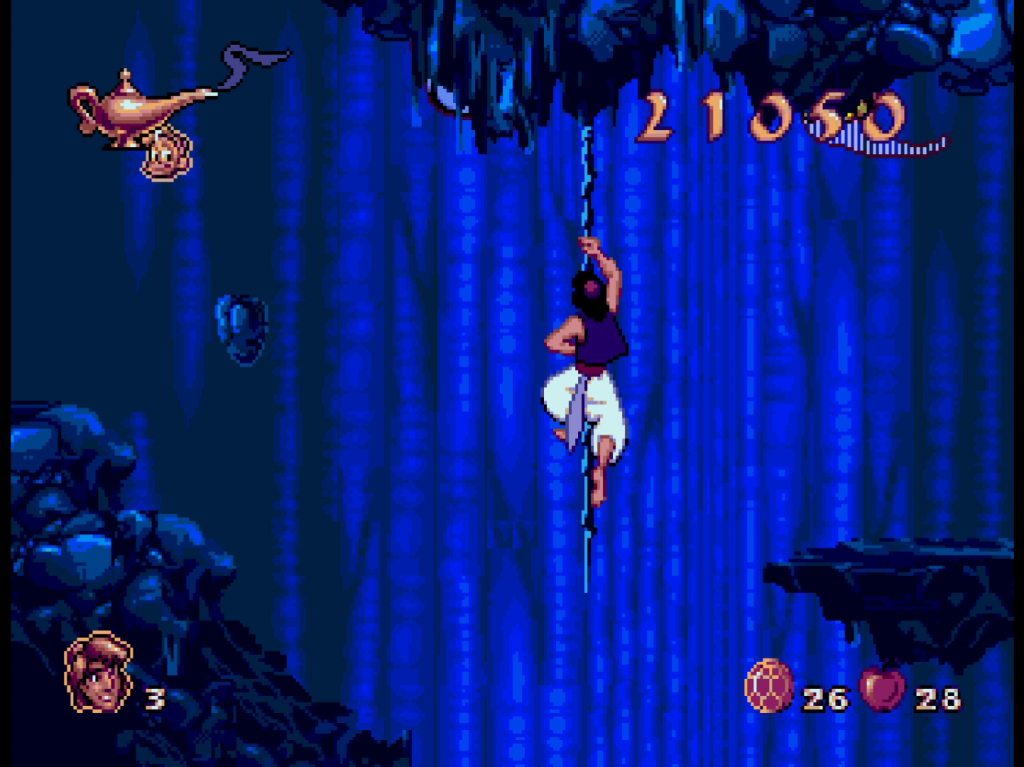
Level 5: Cave of Wonders
The rest of the game more or less lines up with the SNES version from here on out. Aladdin escapes from the dungeon and is taken by Jafar to the Cave of Wonders to find the lamp. He tries and fails to escape the now-falling-apart Cave of Wonders, meets the Genie and then returns to the Sultan’s palace to stop Jafar’s wicked plans.
Throughout both versions of the game, Aladdin can pick up gems and apples. The player uses the apples as projectiles in both games, although only in this version can they defeat larger enemies. But, in the Mega Drive version, the gems serve more of a purpose than just scoring points. In most levels, the merchant character from the movie (the one that’s heavily implied to be Genie) can be found selling extra lives and continues for those collectable gems.
They’re not this game’s only collectables, though. Find Genie’s floating face, and you’ll be able to play a basic roulette game after the level for some extra gems, apples or lives. Find Abu the monkey’s head and a short bonus level will unlock where you can play as him, dodging falling obstacles and picking up as many items as possible.

Abu’s bonus level 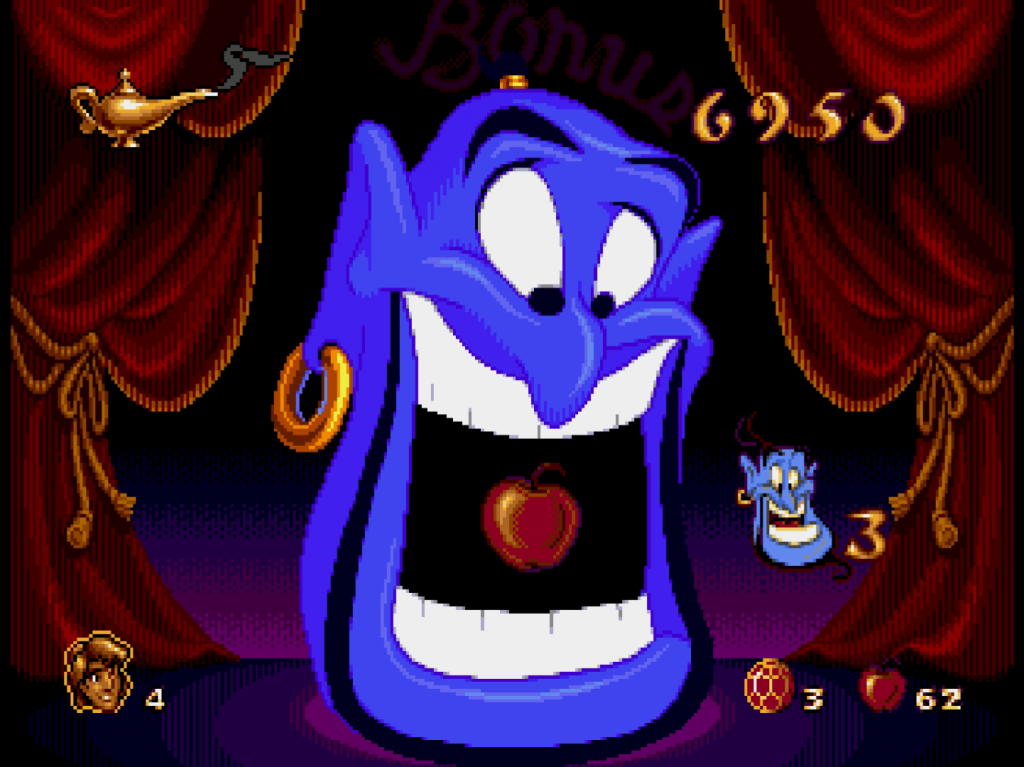
Genie Roulette bonus level
Both versions are platform games – the 90s equivalent of the action-adventure game of today – but they both take quite different approaches to this. This game’s platforming is relatively basic run and jump kind of stuff. Sometimes Aladdin can climb or hang on specific pieces of scenery, and particular levels feature things like moving platforms, springs, etc. Unlike many other platformers, Aladdin must either throw apples or use a sword to defeat his enemies, rather than jumping on them.
The platforming and the combat in this game are, to be honest, not its strengths. Aladdin can be somewhat sluggish to respond to input and falling straight through platforms because you didn’t land on them pixel-perfect is frequent enough to be a notable frustration.
Discerning exactly which element of the scenery is meant to be a platform is often also far more complicated than it should be. The desert level, in particular, uses so many of the same elements as foreground decoration for actual platforms that you have little choice but to just jump around at the walls until you determine the route forward.
General combat is somewhat awkward. Most enemies are much easier taken out with apples than the sword, almost making it worthless. But the real negative comes in the form of the game’s bosses. None of them are particularly fun to fight. Almost – perhaps all – of them essentially require sacrificing your health even to strike them. They aren’t inventive; they don’t use the game’s established mechanics well, and they’re generally just unfair.
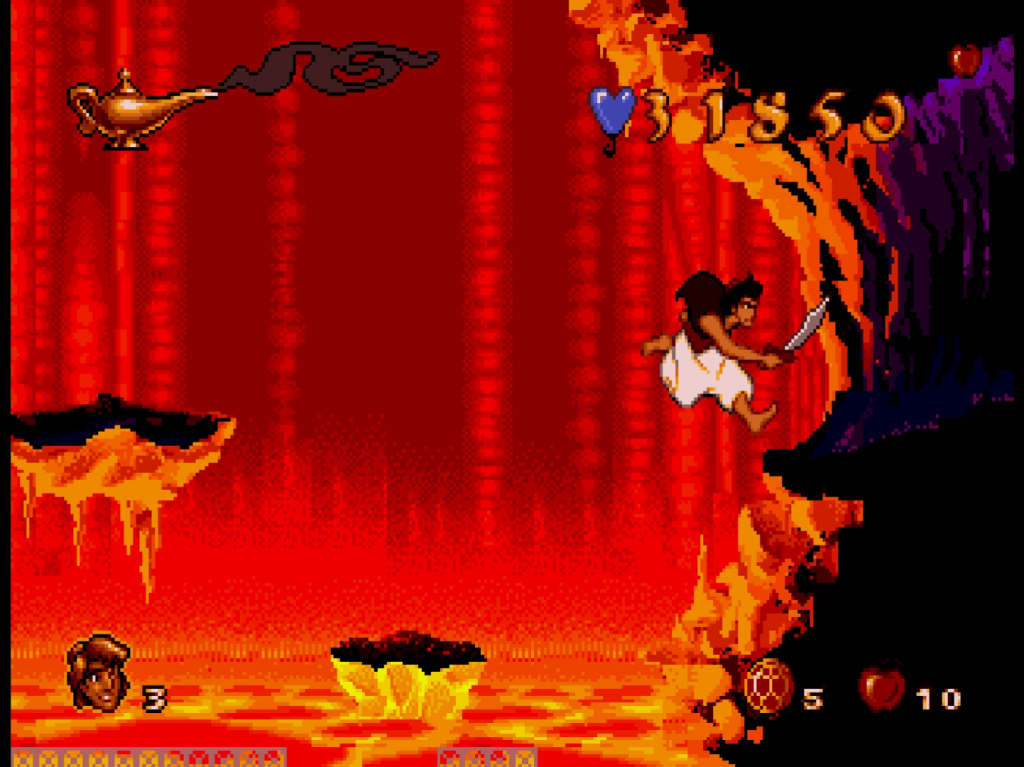
Level 6: The Escape 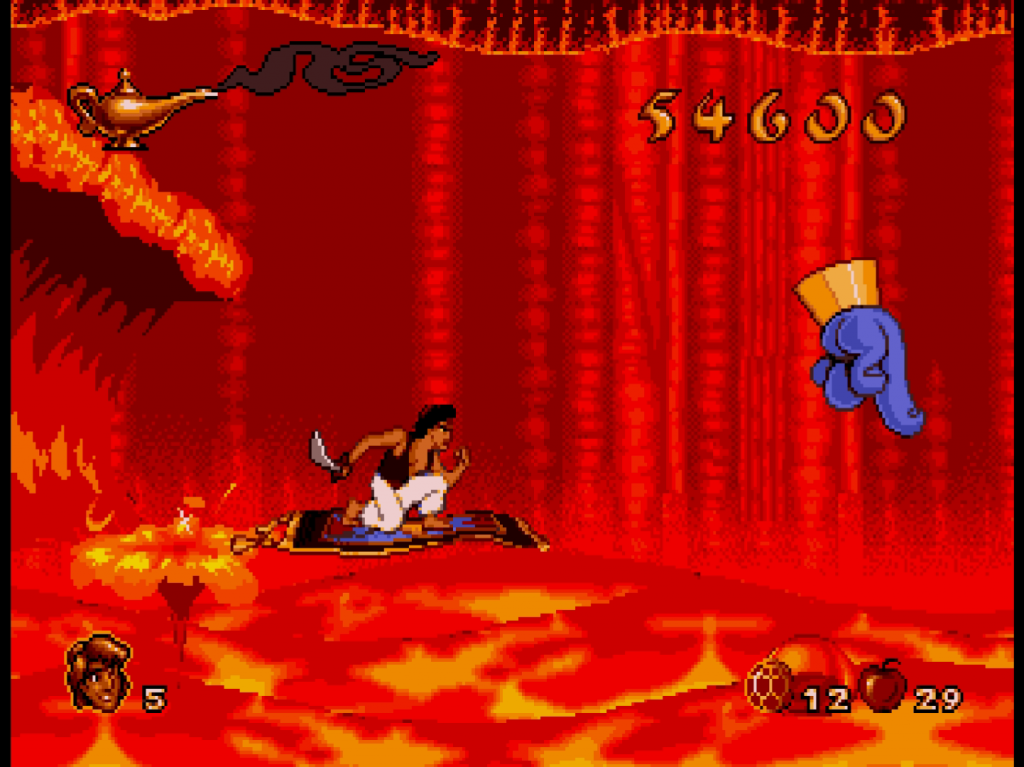
Level 7: Rug Ride 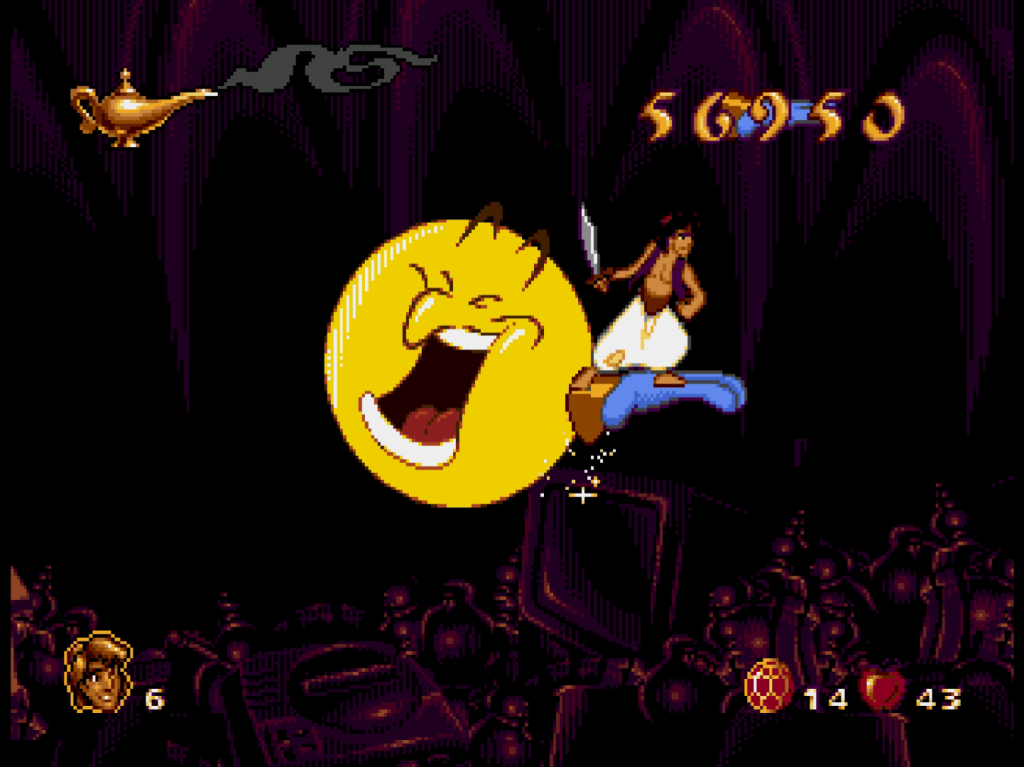
Level 8: Inside the Lamp
This stings the most in the final battle with Jafar. The only way to even harm him is to throw apples at him. If you run out, more will suddenly appear in the off-screen area, but on a platform that catches fire as soon as you stand on it. The fight simply becomes about whether you can throw enough apples towards Jafar to defeat him before you take enough damage to lose a life. It’s both incredibly frustrating and a massive anti-climax to the entire game.
A general feeling of unfairness is common throughout the latter half of the game in particular. Nothing is more indicative of this than the game’s flying carpet level, “Rug Ride”. Fleeing an incoming lava flow, Aladdin must dodge up and down to avoid the oncoming obstacles in his way. At first, this is quite simple – Genie’s hand will point in the safest direction, so you simply have to follow it. As the level progresses, it speeds up, and then Genie starts to give up, shrugs his shoulders and goes “?” instead.
Trial and error, and remembering the specific pattern, is the only way to win here – and in several other instances throughout the rest of the game. That’s not to say this kind of level design wasn’t common for this era. But, not only does it still suck all the same, crucially it wasn’t a problem its Nintendo counterpart suffered from.
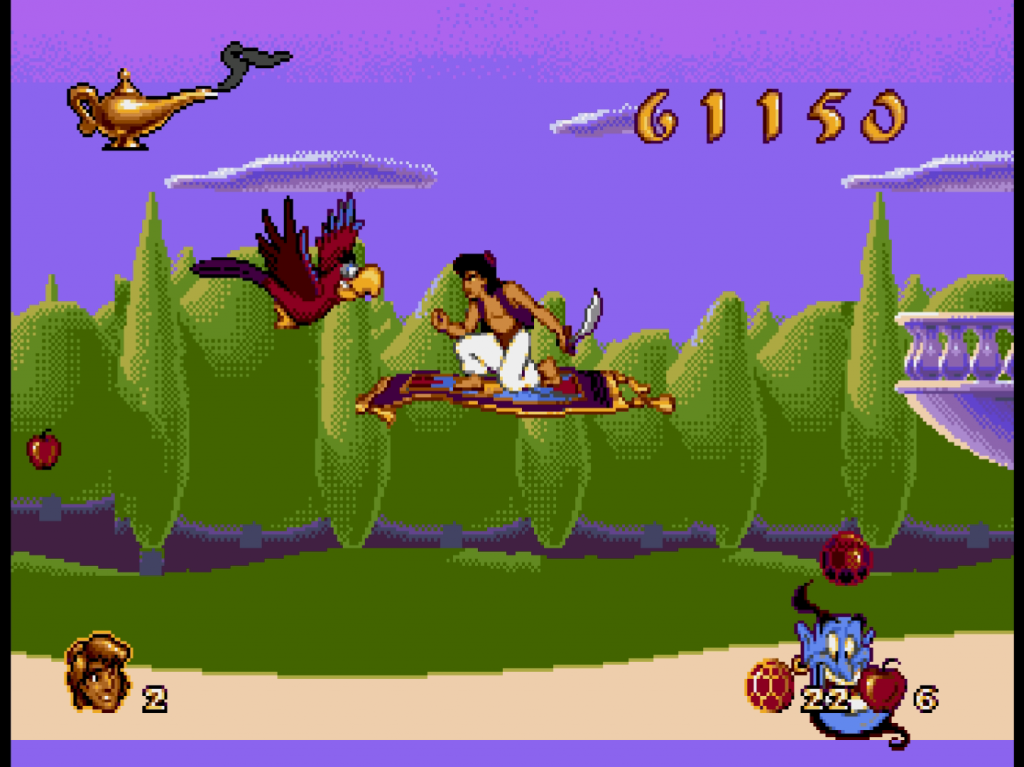
Level 9: Sultan’s Palace 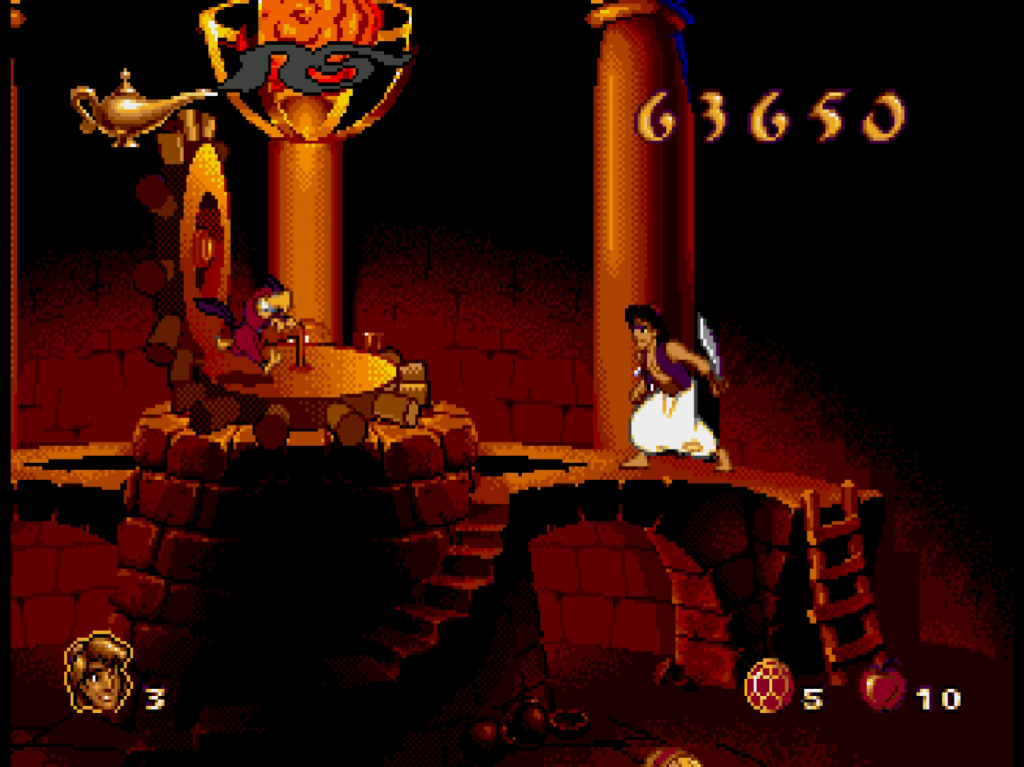
Boss: Iago 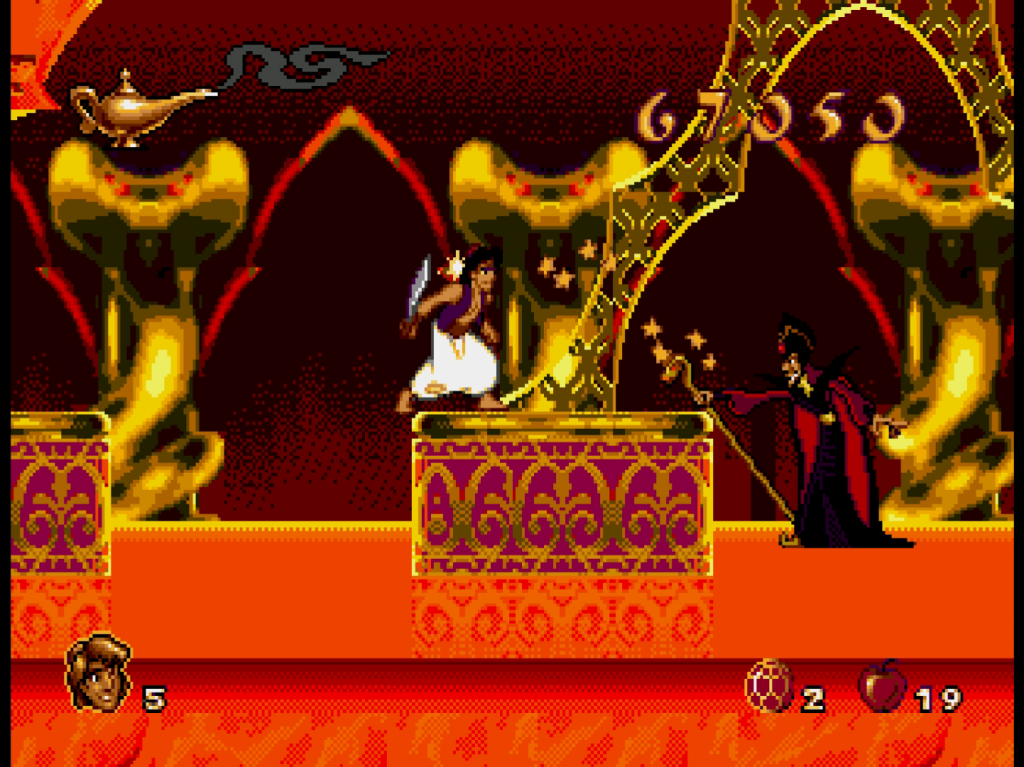
Level 10 / Boss: Jafar’s Palace 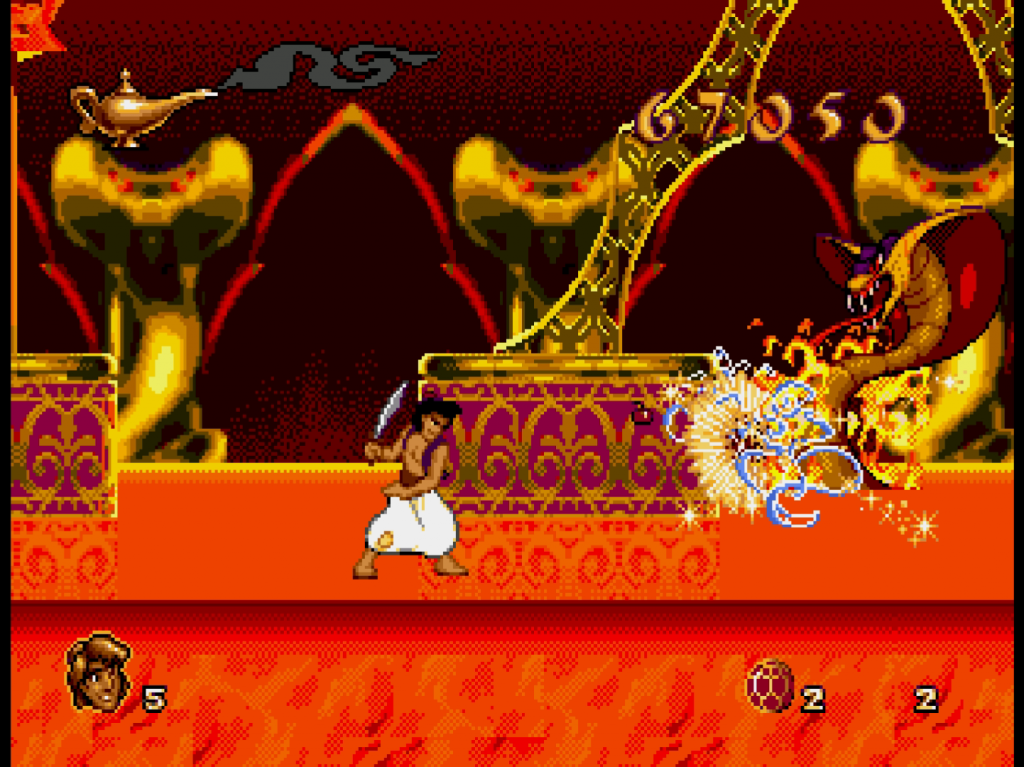
Final Boss: Stage 2 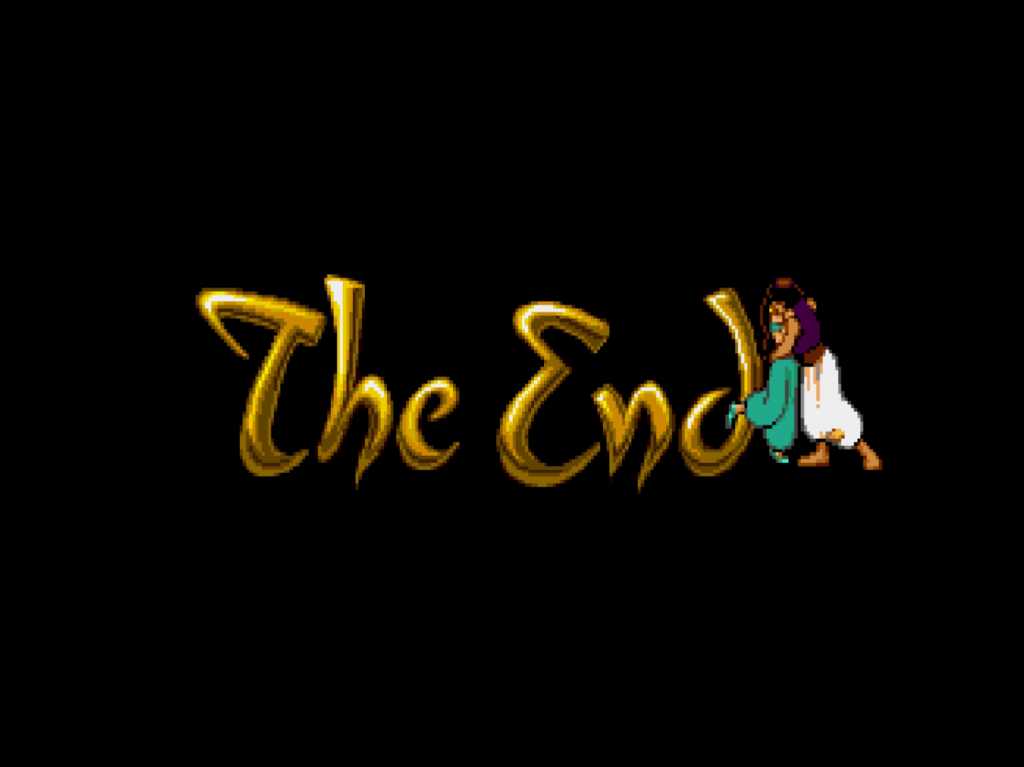
So why is it that the Mega Drive version is so fondly regarded? It all comes down to how otherwise perfectly this game captures the movie it’s based upon. In an industry first, Disney worked directly with Virgin Interactive to create the character sprites and animations in the game. This wasn’t just a pixelated interpretation of Aladdin. This was Aladdin. Straight out of the movie itself. Everything looks right; everything moves right. In 1993, this was groundbreaking. It was, effectively, a chance to play an interactive version of the movie.
The music, meanwhile, was similarly perfectly captured for the Mega Drive by composers Donald Griffin and the ever-talented Tommy Tallarico. As with most Mega Drive games, the tracks were quite bass-heavy, but all were immediately recognisable instrumental recreations of the movie’s iconic songs.
All of this elevated the game beyond its sometimes weak and frustrating gameplay. The Mega Drive version was hugely popular and a critical triumph. The game was so successful that only Sonic the Hedgehog and Sonic 2 ever sold more copies worldwide on the platform.
The SNES version
Capcom’s version of the game, apparently, was made with much less input from Disney. Only a single Disney advisor receives any credit within the game, rather than the significant list that appears on the Mega Drive version. Despite seemingly being left to their own devices with the game’s visuals, though, that doesn’t mean Mikami’s team took liberties with the design.
While everything looks much more ‘video gamey’, the game’s cast is still well presented and immediately identifiable. Disney animators may not have worked on this project, but there’s more than enough life and charm to the animations all the same.
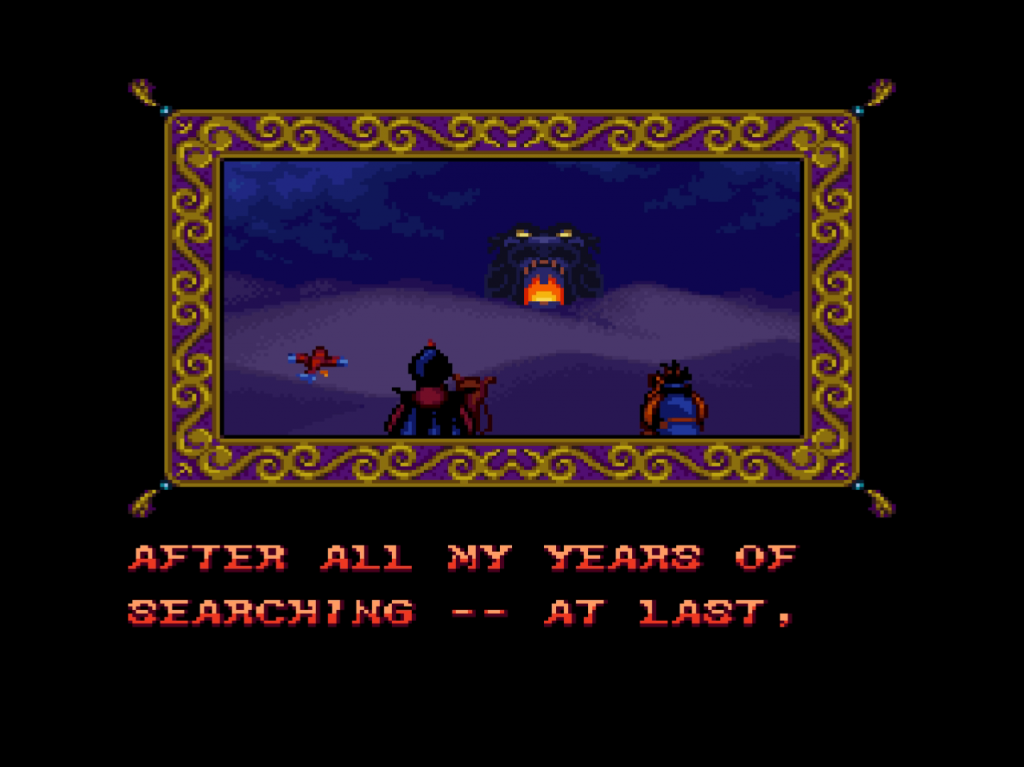
SNES version’s story presentation 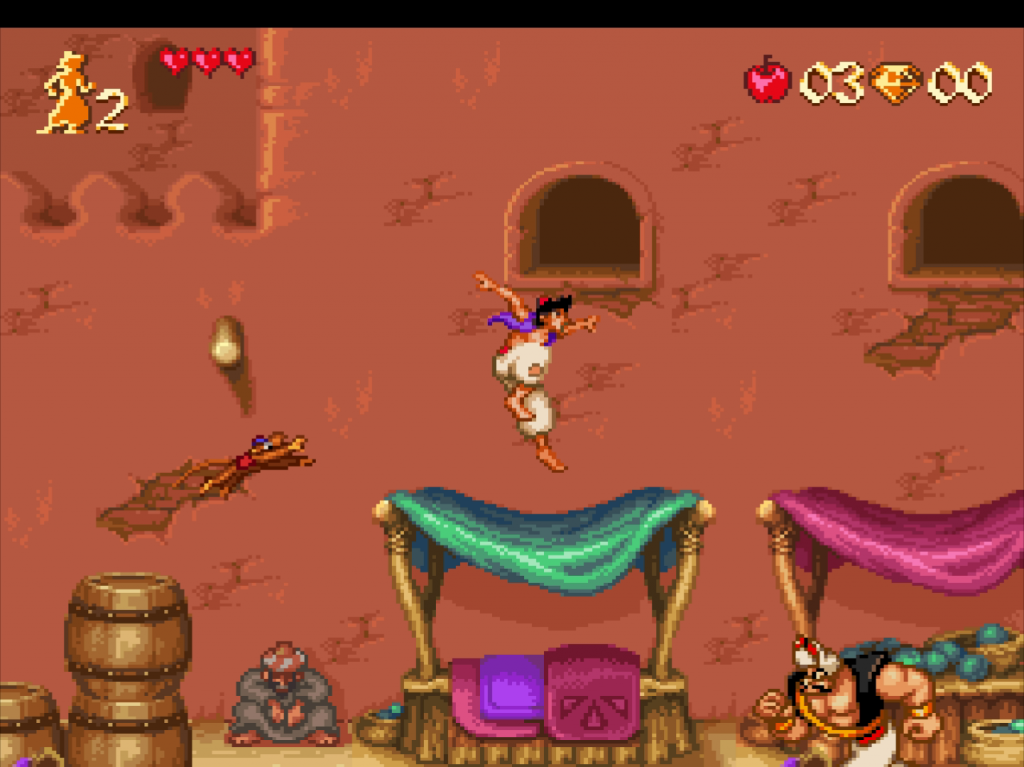
Level 1.1: Agrabah streets 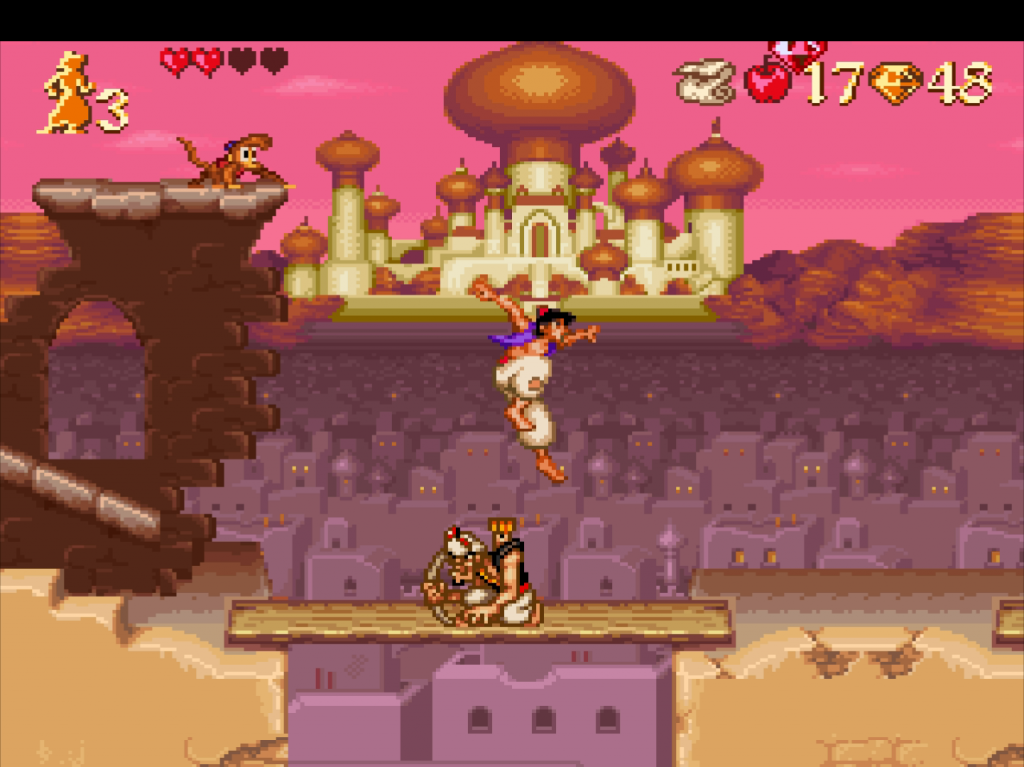
Level 1.3: Agrabah rooftops 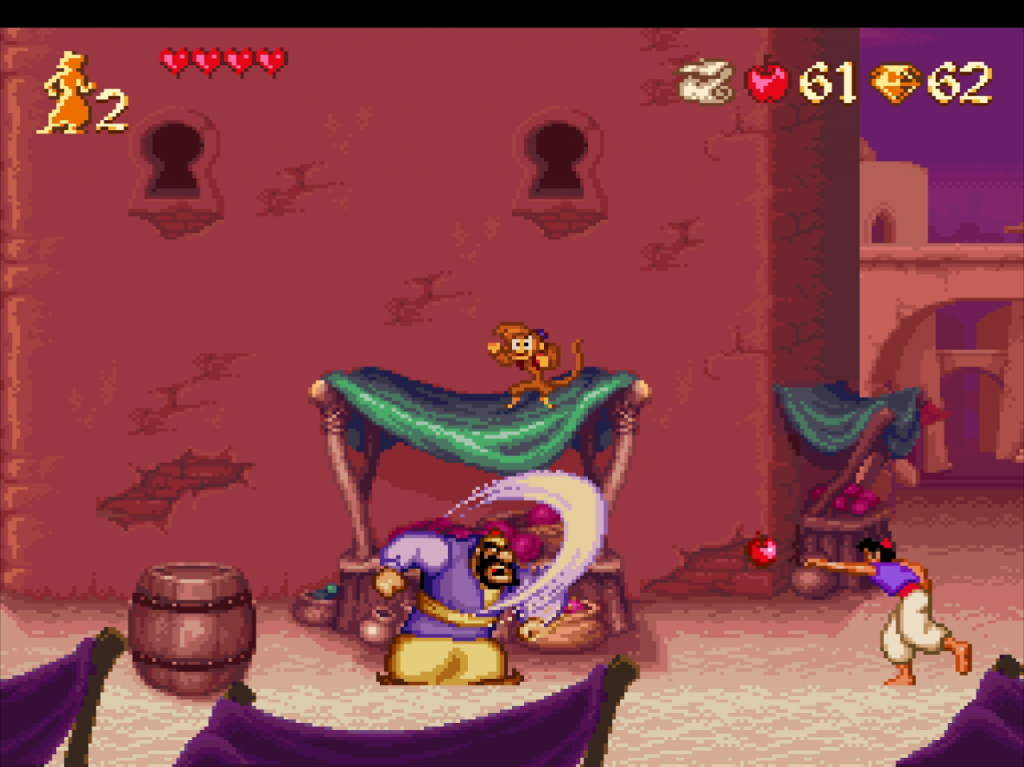
Level 1 Boss 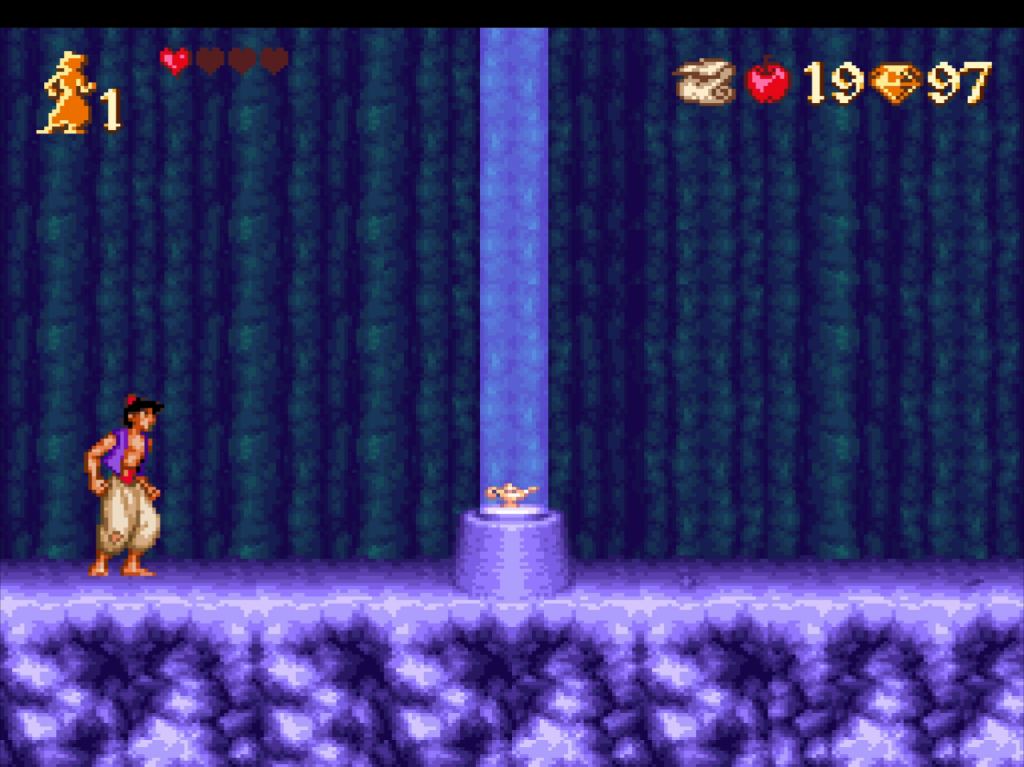
Level 2: Cave of Wonders 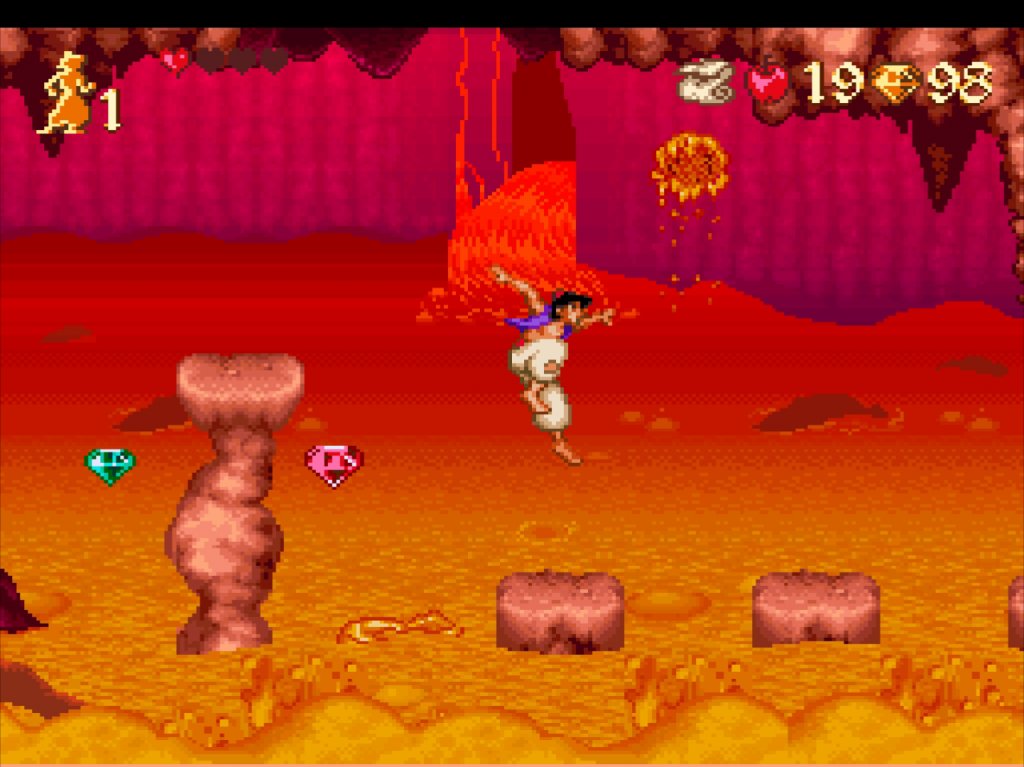
Level 3: Escape
The game’s scenery, platforms and backdrops meanwhile are all much more visually distinct, and representative of Capcom’s already extensive experience of putting the SNES’s abilities to good use. It’s not unfair to say that although the Mega Drive version – especially within the context of 1993 – is hugely visually impressive, the SNES version is much more visually appealing.
The story in this game is not only much closer to the movie’s but is much more detailed as well. There are quite long cut-scenes full of narrative text and dialogue set underneath primarily still recreations of scenes from the movie. As on the Mega Drive, this version also takes a detour into the desert for an extra level, though. In this case, Abu falls from the Magic Carpet on the way back to Agrabah, adding an extra pit-stop for Aladdin before the game’s final level.
Combat in this version lacks the sword entirely, and throwing apples will only stun most enemies. Instead, the game adapts Aladdin’s athletic rooftop antics from the start of the movie into effectively defeating enemies by parkouring over them. This action is also used extensively for certain platforming sections and opening item chests.
The action in the game is stronger, overall. Not only is the game fairer in regards to enemy hitboxes, but enemies having actual attack patterns to respond to makes things much more engaging. This is especially true of the game’s bosses. The final fight with Jafar is still quite tough, but it earns it through having to adapt to several different types of attacks.

Level 4: Rug Ride 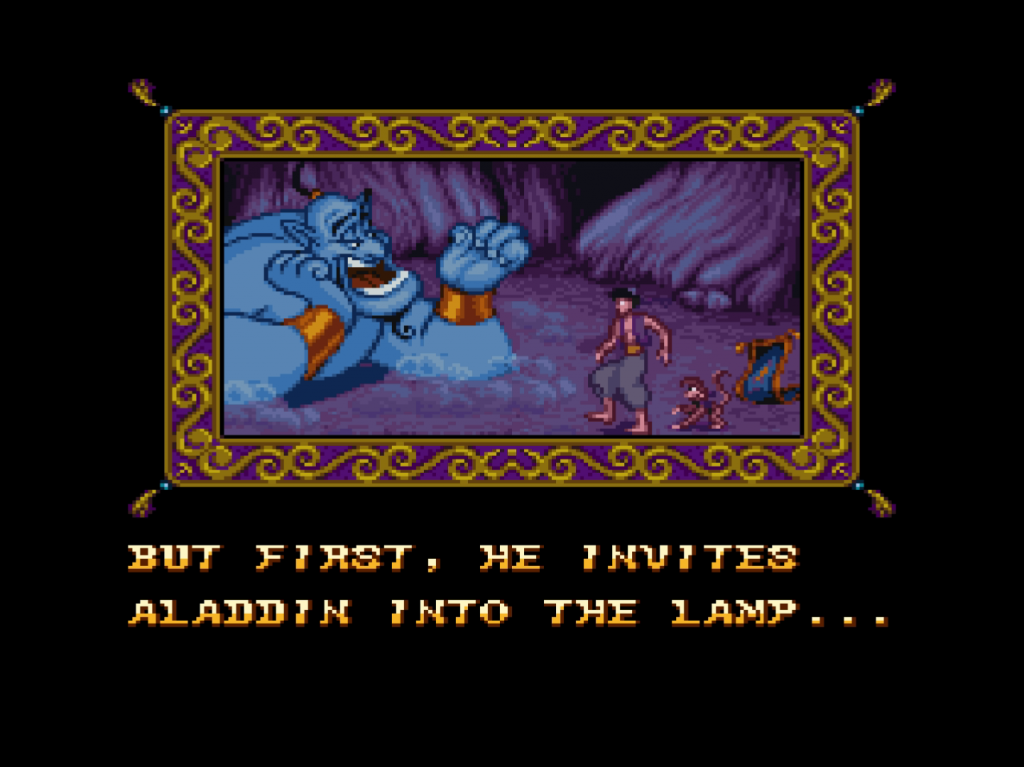
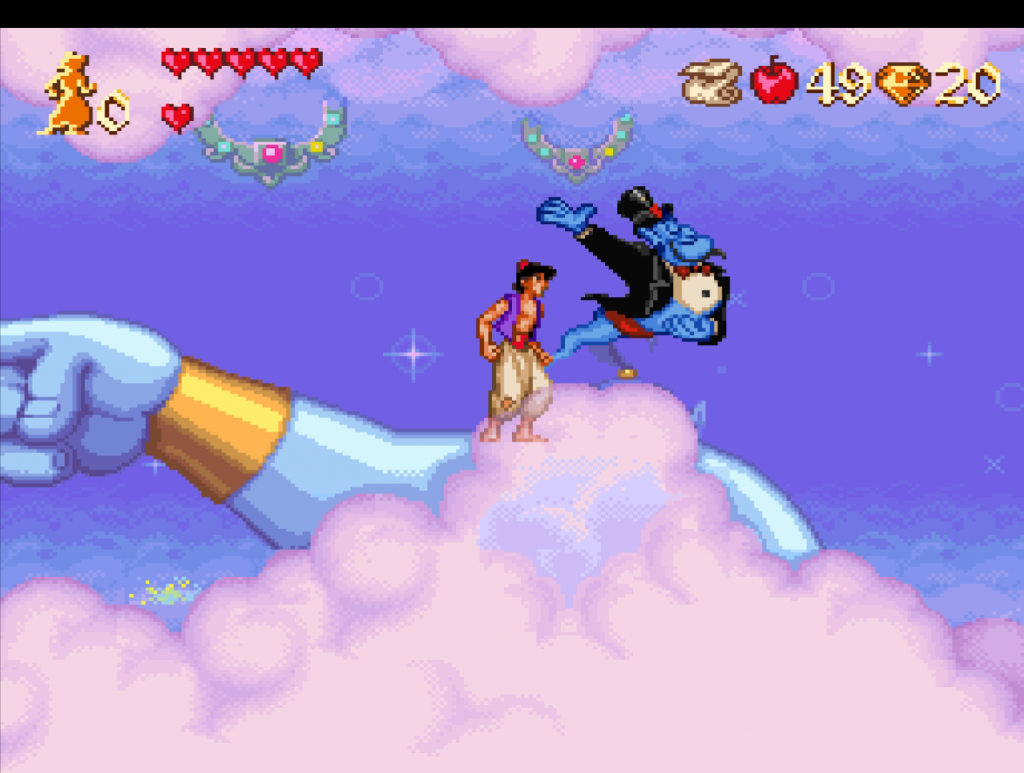
Level 5: Inside the lamp 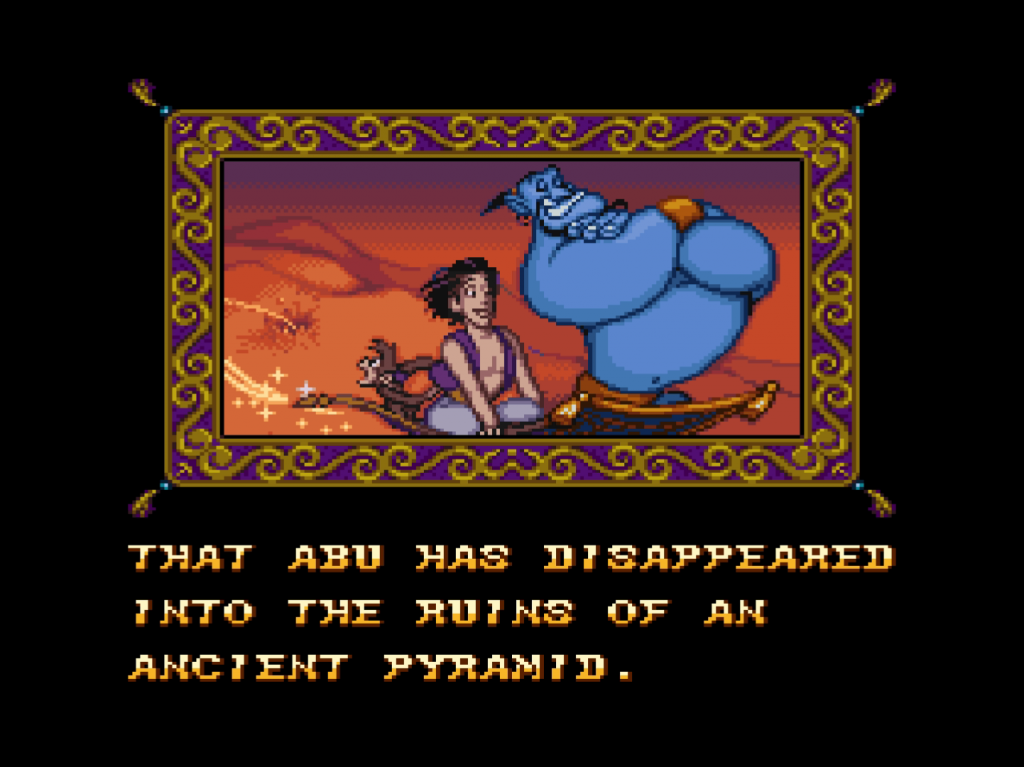
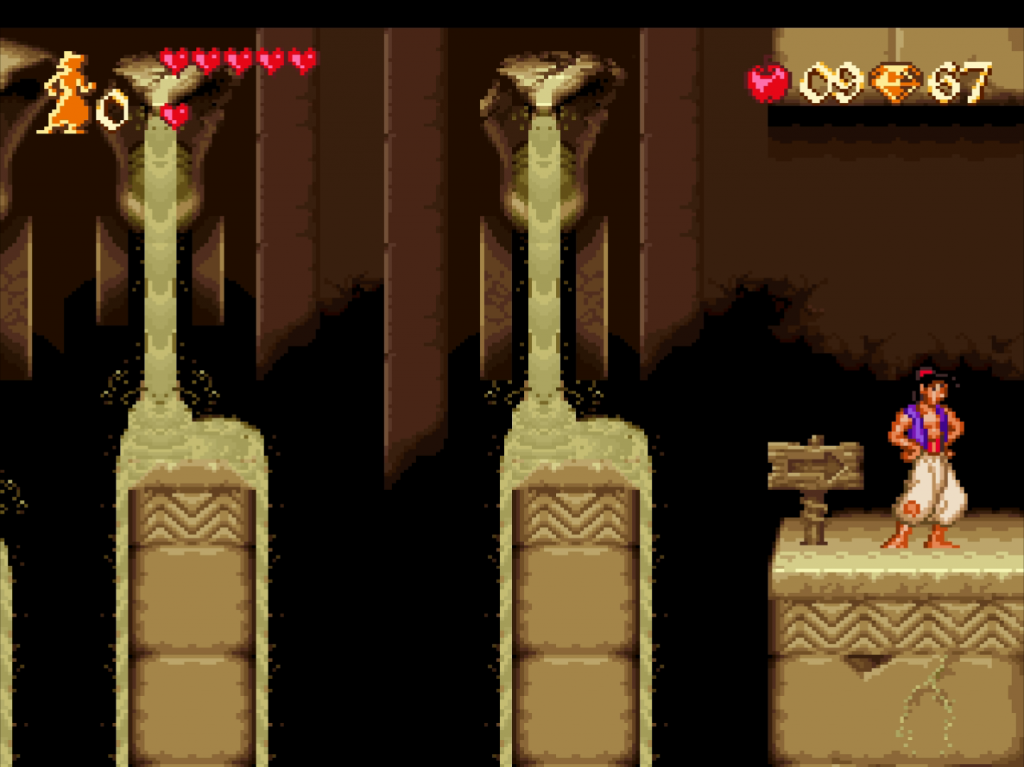
Level 6: Desert Pyramid
Capcom’s game is also slightly meatier than its Mega Drive counterpart. Each level is split into three acts, with a boss fight sometimes taking place at the end. It still won’t take much longer than a couple of hours if you can get to the end in one run either way, though.
While this version has no equivalent of the Abu bonus levels, it does have its own version of the unlockable roulette wheel between stages. As well as extra lives and continues, this bonus round also gives you the chance to earn additional health upgrades that you can keep for the rest of the game. An additional and quite sedate bonus stage sees Aladdin and Jasmine flying through Agrabah at night set to “A Whole New World”. There are no enemies or obstacles here – just gems to collect.
Oddly, neither version of the game adapts – in any way – the introduction of Prince Ali. The music is (somewhat incorrectly) used as the backdrop for the very first level in the Mega Drive version, but the song doesn’t even feature at all in the SNES release. Given that it’s such an iconic and popular scene from the movie, it’s a weird omission that they both make.
Much like the Mega Drive version, the SNES Aladdin was a huge success. It became Capcom’s second best selling SNES game, beaten only by Street Fighter II. Although, reportedly, the Mega Drive version at least doubled Capcom’s 1.8 million worldwide sales.
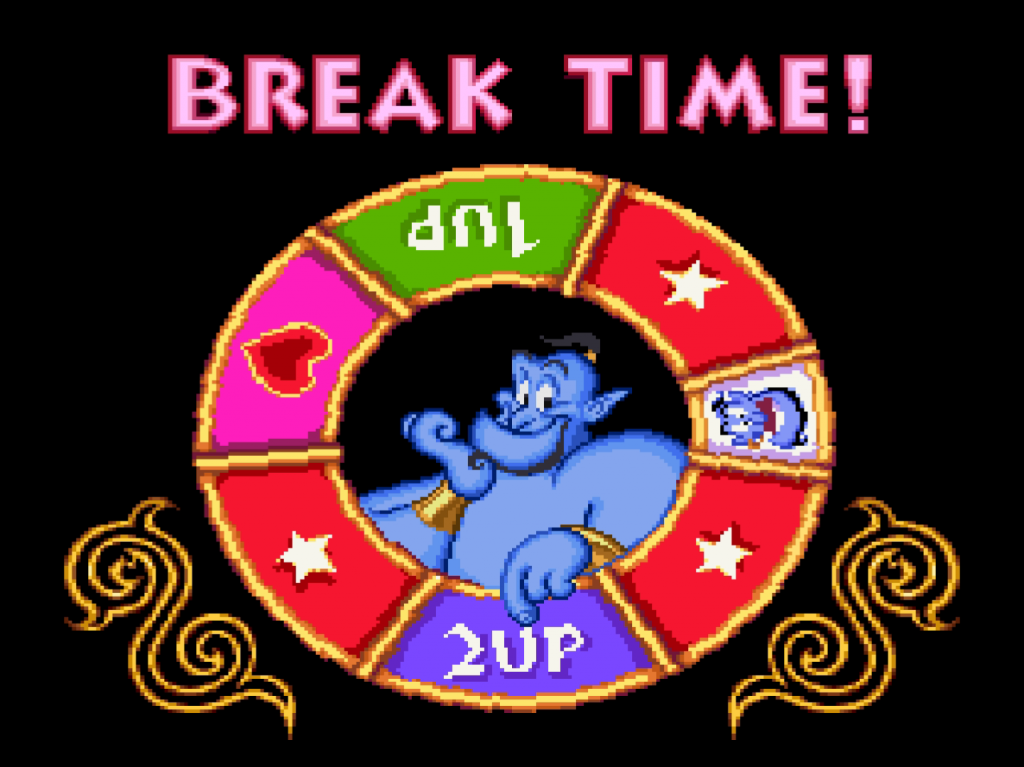
Bonus: Genie Roulette 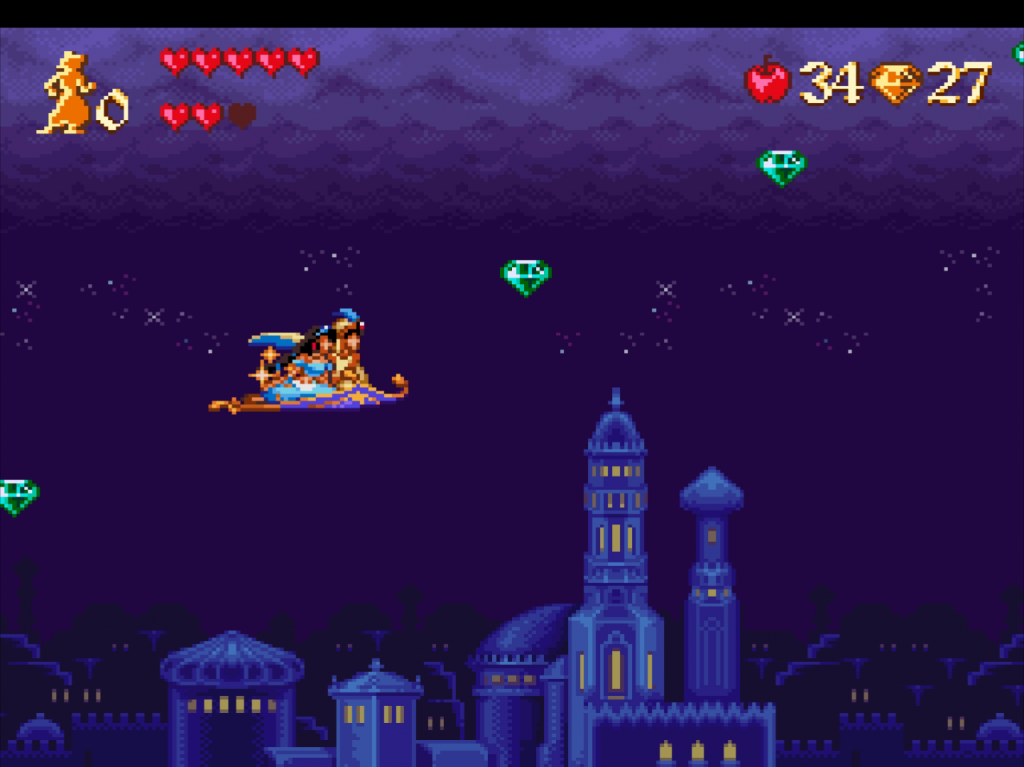
Bonus: A Whole New World 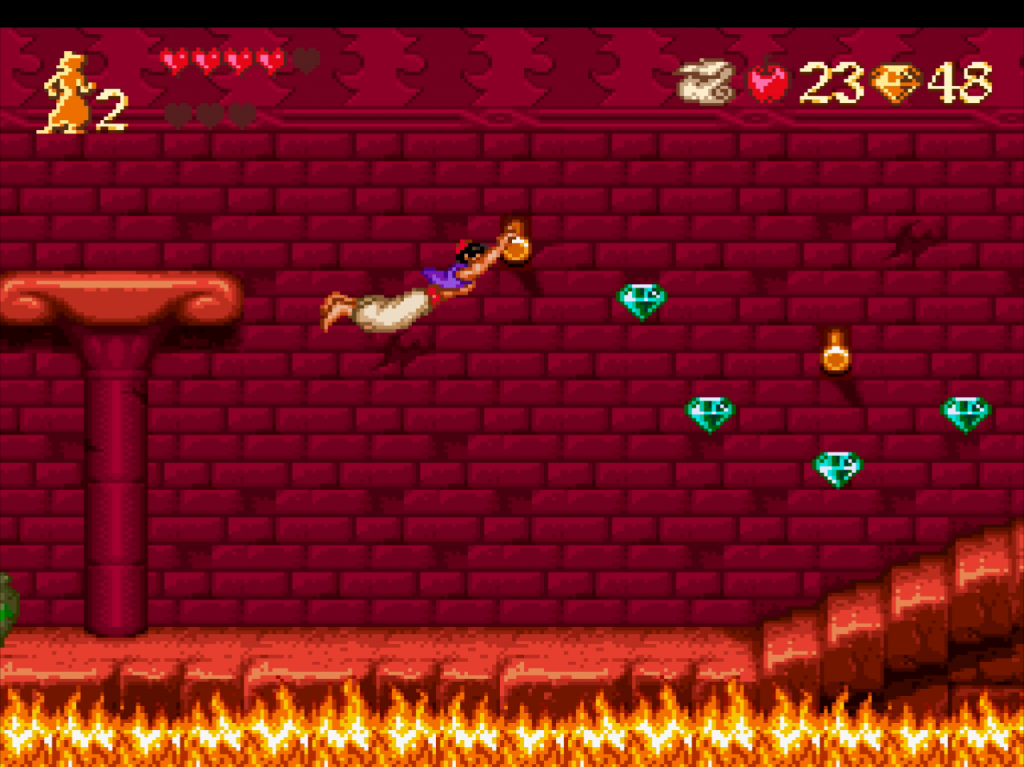
Level 7: Jafar’s Palace 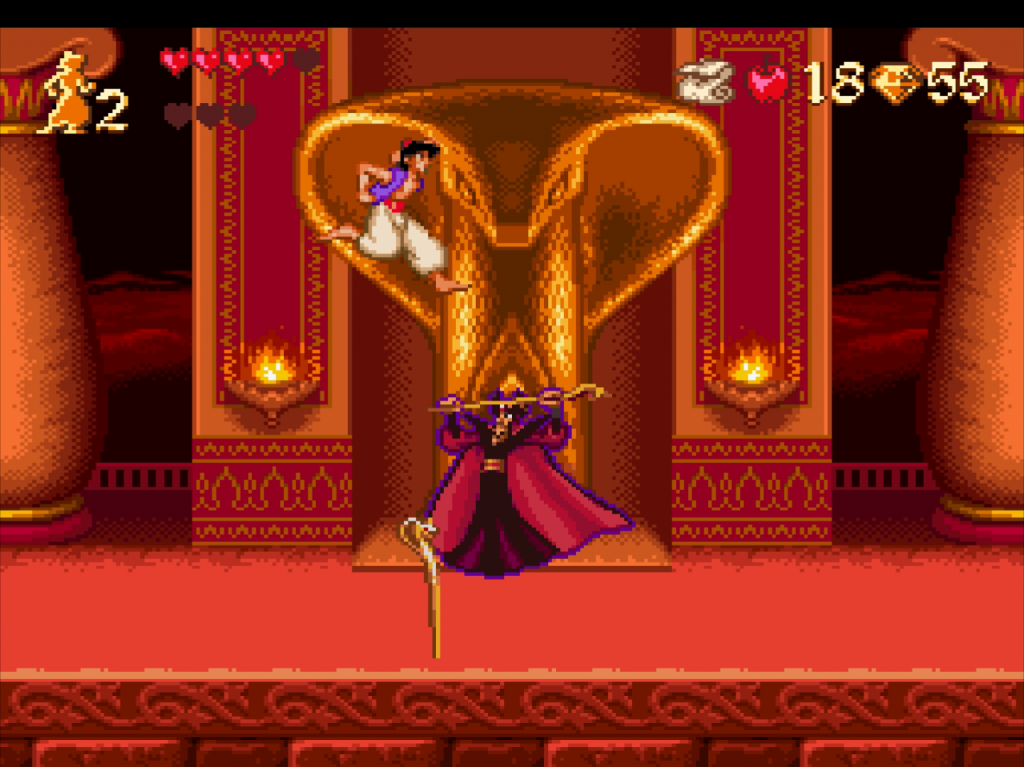
Final Boss – Stage 1 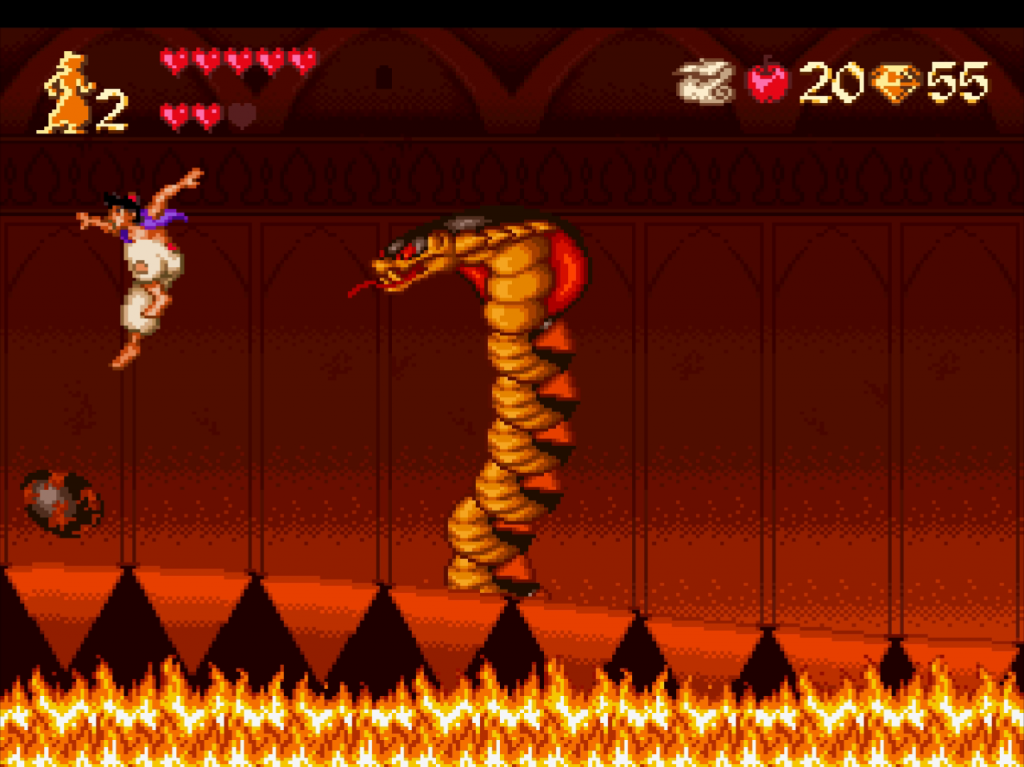
Final Boss – Stage 2
So, which is best?
Ho boy. The truth is, no matter which version of Aladdin you are playing, you’re likely to have a good time. Both are fun games, and both do a great job of bringing the movie to life. In terms of technical achievement – especially for the time – the Mega Drive version stands high above Capcom’s efforts. But the actual gameplay on the SNES is, unquestionably, much stronger overall.
That’s not to say that the Mega Drive version doesn’t claw back advantages over the SNES version, though. Capcom’s interpretation of Genie’s world inside the lamp is quite staid and dull in comparison to David Perry’s proto-Earthworm-Jim style version.
However, it is the Capcom version that’s most worth playing today. Focused much more on delivering as a game, it just stands the test of time so much better. A more extensive range of hidden – or hard to get – items to master 100% completion also means there’s just more to do as well. Unfortunately, this version has been largely ignored for ports and re-releases in favour of Virgin’s. Aside from a poorly-received Gameboy Advance version, emulation or the original SNES cart remains the only way to play it today.
Meanwhile, the good news for fans of the Mega Drive version is that a new re-release is just around the corner. Landing on the Switch, PS4, Xbox One and PC on the 29th October. This version, bundled alongside Virgin’s SNES version of The Lion King, includes a new “final cut” version of the game, as well as the Game Boy version and a trade show demo. It even comes with features like save states and rewind, so the Rug Ride level is about 50% less terrible.
At least something good has come of those live-action movies, eh?






